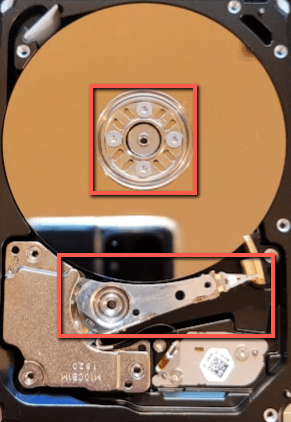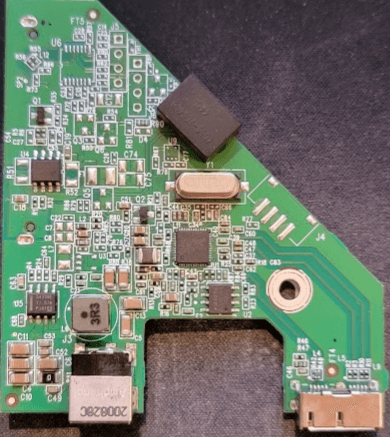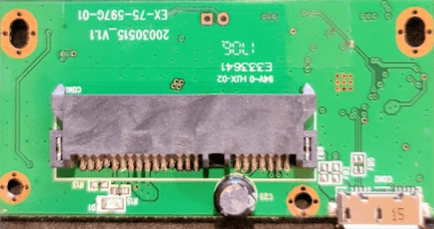There used to be a time when a silent hard drive was cause for concern. Thirty years ago hard drives were a little noisy and were usually only silent when the computer was off or there was a problem with the drive or the PATA connection. Nowadays, silent hard drives are the norm, and beeping or clicking means problems.
Hi, I’m Aaron. I’ve been using computers long enough to remember when a noisy hard drive was a good thing and am happy that computers are much more silent now. I’ve had my fair share of hard drives stop working and I’m here to help you with yours.
Let’s take a look at why your Seagate hard drive might be beeping and what you can do about it.
Table of Contents
Key Takeaways
- There may be a cable issue causing your Seagate external hard drive to beep.
- If it’s not a cable issue, it could be an adapter issue.
- It could also be an issue internal to the hard drive, which requires drive repair or recovery.
- Drive repair and recovery is expensive. You need to back up critical data.
Why Your Seagete Hard Drive Beeps
A hard drive, as opposed to a solid-state drive, has moving components. In the middle of the drive is a spindle powered by a motor that typically spins at either 5400 or 7200 times per minute. At the bottom of the drive is a set of read heads, tiny magnets on arms that move along the magnetic platters to read information.

I provided an image of the inside of a hard drive so you don’t have to open one. The one pictured above is broken and the data is unrecoverable. Opening a hard drive in an improper environment without knowing how to handle it will result in the hard drive breaking.
Each of those components makes different sounds when they cease to work correctly. The arms make a clicking noise when they’re unable to freely move over the platters. The spindle makes a beeping or whining sound when it is unable to spin the platters.
Knowing how a hard drive works makes it straightforward to diagnose. There are only three things that prevent the motor from spinning the spindle: there’s not enough power, the spindle is stuck, or the motor is stuck.
Causes and Fixes for a Beeping Hard Drive
I’ll work through the causes and fixes for a beeping hard drive, starting with those causes most easily fixed by you and working up to those that you likely can’t fix yourself. Let’s start with…
1. Cable or Port Issues
There are three components responsible for power delivery to an external hard drive: the cable from the computer to the external case, the USB to SATA conversion board, and the hard drive board.
If your drive isn’t receiving enough power, it could be because of a damaged cable or a damaged USB port. Both are very possible and happen somewhat commonly. If you plug and unplug your hard drive often, then the cable is more likely the culprit.
Your best bet to fix this is to buy a new cable and plug it in. If the cable works, great! You fixed it by replacing the cable. If that doesn’t work, then change the port and try it again.
You may also have an external hard drive that has a separate power source. If it does, you can try using a different power plug.
If changing the cable, port, and power supply doesn’t work, then you might have…
2. Board Problems
External hard drives use an adapter to translate the SATA connection on the drive to USB which easily connects to your computer. Those adapters come in three general flavors.
One is an adapter with a separate power source. Those are typically used with enclosures for 3.5-inch drives or multiple drives.

Another is an adapter with no separate power source, which is powered by a USB connection. That adapter is typically used with 2.5-inch hard drives or solid-state drives.

The final is an adapter that is built into the hard drive controller circuit board. In that case, the hard drive controller just has a USB connection and lacks a SATA connection.
Before going further with troubleshooting, I would recommend opening your external enclosure and removing the drive. That may result in the destruction of the enclosure. If you’re unsure whether or not there’s a separate SATA to USB converter, don’t open it. You will void your warranty if you open the enclosure.
If you know that you have a SATA drive with a USB converter, you can open the external enclosure and buy a new one. Buy an enclosure or SATA to USB converter that corresponds with the connectivity and power needs of the original enclosure.
If that’s not the issue, or if you have a hard drive controller board with only a USB port, then your hard drive controller board may be damaged and unable to deliver power appropriately. You’ll either need to replace it with a known good board from the exact model, get the data recovered from the drive, or buy a new drive.
If that’s not your issue, then you have…
3. Spindle Issues
There are a few reasons that the hard drive spindle won’t work. The spindle bearings may be seized, the reading arms may be stuck and prevent the spindle from spinning, or the spindle motor may be broken.
If you’re reading this article, then none of those issues are fixable by you. Repairing spindle issues requires opening the hard drive–which can break it if you don’t know what you’re doing–and replacing the broken component.
At that point, your options are repairing the drive and recovering data from the drive, or replacing the drive.
A Note About Repair and Recovery
If you have very important data on your external drive and you don’t have another backup, then the only way to get the data back is to repair the drive or recover the data.
Repairs can cost hundreds of dollars. Recovery can cost hundreds to thousands of dollars, depending on the damage, and aren’t guaranteed to recover all data.
Because of that, I highly recommend that you back up all important data somewhere else so you can recover it. Losing a hard drive shouldn’t mean losing your critical data. If it does, you may pay a large sum of money to recover the data.
FAQs
Here are some commonly asked questions about Seagate external hard drives beeping.
Can a Beeping Hard Drive be Fixed?
Yes! Although depending on why it’s beeping, that may be a more or less expensive proposition.
How do I know if My External Hard Drive is Failing?
When the drive makes noise, either beeping or clicking, that’s a really good sign. Alternatively, if the hard drive doesn’t appear when you plug it in, that typically means the hard drive is in the process of or has failed.
Why is My Seagate External Hard Drive Beeping and Not Recognized by Xbox One?
For the same reasons your Seagate external hard drive is beeping and not recognized by your computer. There’s either a problem with the power delivery path or the drive spindle.
Conclusion
There are a few reasons your Seagate external hard drive will beep. Some of those are fixable by you, but some aren’t. The ones that aren’t can result in expensive repair or recovery fees. If you need the data back and don’t have a backup, those fees are inevitable.
Have you had major external hard drive issues? Let me know in the comments below what you did to fix them!
